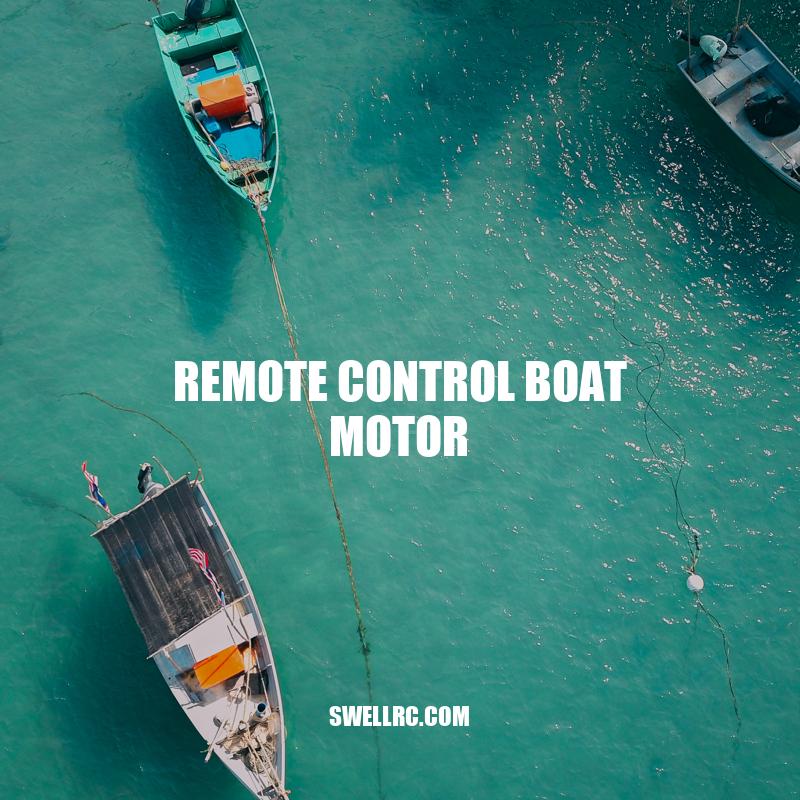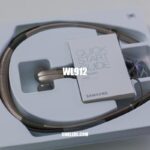Guide to Remote Control Boat Motors
Remote control boat motors are a fascinating piece of technology that provides endless fun and excitement on the water. With the ability to control your boat from the shore, you can experience the thrill of racing or even fishing with ease. These miniature motors have become increasingly popular among boating enthusiasts due to their ease of use, affordability, and versatility. Remote control boat motors offer a great alternative to traditional boating and are a fantastic way to enjoy the water without worrying about the expenses and logistics of owning a full-size boat.
There are many different types of remote control boat motors available, including electric and gas-powered models. Electric motors are the most popular choice among boating enthusiasts as they are quieter, more environment-friendly, and require less maintenance than their gas-powered counterparts. They are also great for beginners as they are easy to operate and control. On the other hand, gas-powered motors offer more power and are ideal for racing boats or larger vessels. However, they require more maintenance and can be noisy and expensive to operate.
Installing a remote control boat motor can be a daunting task, especially if you are new to this technology. However, with the right instructions and tools, it can be a relatively straightforward process. The installation process generally involves several steps, including mounting the motor, connecting the motor to the boat’s battery, and installing the remote control system. Following the manufacturer’s instructions is crucial to ensure a safe and seamless installation.
Types of Remote Control Boat Motors
- Electric motors are a popular choice as they are quieter, environment-friendly and require less maintenance
- Gas-powered motors offer more power and can be great for racing boats
- Brushless motors are more efficient, require less maintenance and can run at higher speeds
When it comes to choosing the right motor for your boat, there are several factors to consider. Some of these factors include the type of boat you’ll be using, your desired speed and power, and of course, your budget. Electric motors tend to be more affordable and easier to install, making them a perfect choice for beginners or those operating small boats. Gas-powered motors, on the other hand, are more powerful and can handle larger boats and higher speeds.
If you’re looking to purchase a remote control boat motor, it’s essential to do your research and find a reputable retailer or website that offers quality products. Some popular websites that sell remote control boat motors include Amazon, HobbyKing, and MotionRC. Additionally, be sure to check customer reviews and ratings before making a purchase decision. A high-quality motor can offer you years of fun and excitement on the water, while a cheaper, low-quality motor can lead to frustration and breakdowns.
Pros of Remote Control Boat Motors
| Pros | Cons |
|---|---|
| Easy to control and operate | Can be challenging to install |
| Affordable compared to full-size boats | May require some maintenance and repairs |
| More environmentally friendly than gas-powered boats | May not offer the same power and speed as gas-powered boats |
| Great for racing, fishing, or just having fun on the water | Can be dangerous if not used properly |
Overall, remote control boat motors are an excellent investment for anyone looking to experience the thrill of boating without the hassle and expense of owning a full-size boat. With the right motor, you can have endless hours of fun and excitement while exploring new waters and perfecting your boating skills.
How to choose an RC hobby motor for electric boat?
When it comes to choosing an RC hobby motor for your electric boat, there are a few things that you should keep in mind to ensure that you pick the right motor for your needs:
- Consider the size and weight of your boat: The size and weight of your boat will play a significant role in determining the type of motor that you need. A larger, heavier boat will typically require a more powerful motor to provide adequate speed and performance.
- Choose the right type of motor: There are two main types of motors that you can choose from for your electric boat – brushed and brushless. Brushed motors are generally more affordable, but they tend to require more maintenance. Brushless motors, on the other hand, are more expensive but offer higher speeds and smoother operation.
- Determine the voltage and amperage requirements: Before choosing a motor, make sure that it is compatible with the voltage and amperage requirements of your boat’s battery. Choosing a motor that requires too much power can cause damage to your battery or the motor itself.
- Consider the propeller: The size and pitch of the propeller will impact the performance of your motor. Different propellers are better suited for specific applications, so make sure that you choose one that is appropriate for your boat and motor.
If you’re unsure about which motor to choose, there are several websites and products that can help guide you in the process, such as HobbyKing and Tower Hobbies. These websites offer a range of motors and can provide information on the specific requirements needed for your boat.
Installation of Remote Control Boat Motors
- Before installation, read the manufacturer’s instructions carefully to ensure a seamless and safe installation
- Prepare the boat by removing any existing motor and cleaning the motor mount area
- Attach the motor mount to the boat using screws or bolts and nuts
- Attach the motor to the mount using screws or bolts
- Connect the cables to the motor and the battery as per the instructions provided
- Test the motor to ensure that it is functioning properly and adjust the position of the motor if necessary
The installation of a remote control boat motor can be challenging, especially for beginners or those unfamiliar with boats. However, with the right tools and instructions, it can be a relatively straightforward and enjoyable process. One important factor to keep in mind is safety. Always ensure that the boat is stable and that the motor is securely mounted to the boat before testing it out on the water.
Common Tools and Materials Needed for Installation
| Tools | Materials |
|---|---|
| Phillips and Flathead screwdriver | Motor mount kit |
| Wrench pliers | Cables and connectors |
| Wire stripper | Battery terminals |
| Heat gun or soldering iron | Drill and drill bit set |
While some of these tools may be familiar to the average DIY enthusiast, others may require a bit more research or expertise. Fortunately, there are several websites and forums online that offer helpful tips and advice for installing remote control boat motors. Some popular websites that offer assistance with installation include RCGroups, Instructables, and RC Universe.
Whether you’re a seasoned boater or a beginner, installing a remote control boat motor can be a rewarding and exciting experience. With proper care, maintenance, and a bit of creativity, you can customize your boat to suit your individual tastes and preferences and enjoy countless hours of fun and adventure on the water.
How to Install a Boat Motor
Installing a boat motor can be a challenging task, especially if you have never done it before. Here are some basic steps that will guide you through the process:
- Remove the old motor from your boat.
- Choose the right size motor for your boat.
- Attach the motor to the boat transom.
- Connect the steering and throttle cables to the motor.
- Attach the propeller to the motor.
- Fill the motor with oil and gas.
- Test the motor on the water before heading out on a long trip.
There are plenty of online resources available that offer more detailed instructions and installation guides. Be sure to consult these resources and follow all safety precautions carefully. Additionally, many boating and marine supply stores sell motors and offer installation services or advice if needed.
Maintenance of Remote Control Boat Motors
- Regularly clean the motor and propeller with a soft cloth and warm, soapy water
- Check the propeller regularly for any signs of damage or wear, as this can affect the motor’s performance
- Inspect the cables for any fraying, kinks, or other signs of damage
- Replace any worn-out parts such as cables or propellers promptly
- Store the motor and boat properly when not in use, and protect them from extreme temperatures or weather conditions
Regular maintenance is crucial for the proper functioning and longevity of a remote control boat motor. Neglecting to maintain the motor can result in poor performance, malfunction, or even damage to the boat. In addition to cleaning and checking for damage, it is also essential to periodically lubricate any moving parts or fittings.
Popular Products for Maintenance of Remote Control Boat Motors
| Product Name | Description | Price |
|---|---|---|
| Boeshield T-9 Rust & Corrosion Protection | A waterproof lubricant that prevents rust and corrosion on metal surfaces | $18.99 |
| XOAR PJA Professional Series Boat Propeller | A high-performance propeller made from high-quality wood composites | $59.99 |
| PowerPro Super 8 Slick Fishing Line | A durable and smooth fishing line that is great for use with remote control boats | $17.99 |
There are several products on the market that can make maintenance of a remote control boat motor easier and more efficient. Some popular products that have received positive reviews from boat enthusiasts and professionals include Boeshield T-9 Rust & Corrosion Protection, XOAR PJA Professional Series Boat Propeller, and PowerPro Super 8 Slick Fishing Line.
In addition to using these products, it can also be helpful to consult online forums and websites for advice on how to maintain your remote control boat motor. Some popular forums that offer assistance with maintenance include the RCGroups and RC Universe forums.
How do remote control boats work?
Remote control boats, also known as RC boats, are miniature boats that can be controlled from a distance using a controller. These boats operate using a few basic components, including a motor, battery, and a receiver located in the boat. Here are some key points about how they work:
- The controller sends signals to the receiver located in the boat, which then controls the boat’s functions and movements.
- Most RC boats operate using an electric motor, but some advanced models use internal combustion engines.
- Most RC boats run on rechargeable batteries, which can vary in voltage depending on the size and power of the boat.
If you’re interested in purchasing an RC boat, there are numerous websites and products available, including models for both beginners and experienced users. Before purchasing, consider the size and type of boat that will be best suited for your needs, as well as any additional features you may want.
Precautions to be Taken While Using Remote Control Boat Motors
While remote control boat motors offer an exciting way to enjoy time on the water, it is essential to take proper precautions to ensure the safety of yourself and others around you. Here are some precautions to keep in mind:
- Always check the weather forecast before venturing out, and avoid using the boat in rough or inclement weather conditions
- Wear a personal flotation device (PFD) at all times to stay afloat in case of an accident or emergency
- Inspect the boat and motor regularly for signs of damage or wear, and address any issues promptly
- Ensure that the boat’s battery is charged and ready to use before heading out
- Use the boat in designated areas and follow all local laws and regulations regarding boating
By taking these precautions, you can minimize the risks of accidents or malfunctions and enjoy remote control boating safely and responsibly. It is also important to ensure that you have proper training and experience before operating a remote control boat motor, particularly if you are using it for racing or other competitive purposes. With the right mindset and safety measures in place, remote control boating can be a fun and rewarding activity for enthusiasts of all ages.



